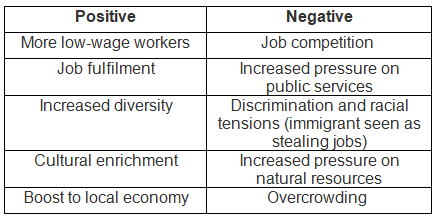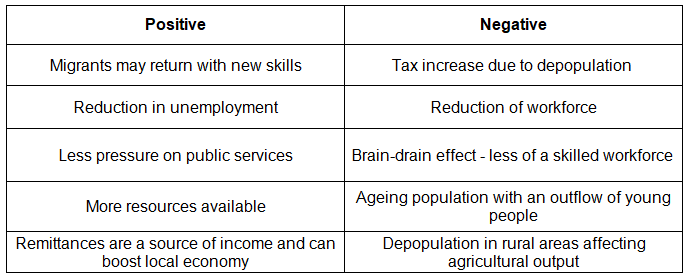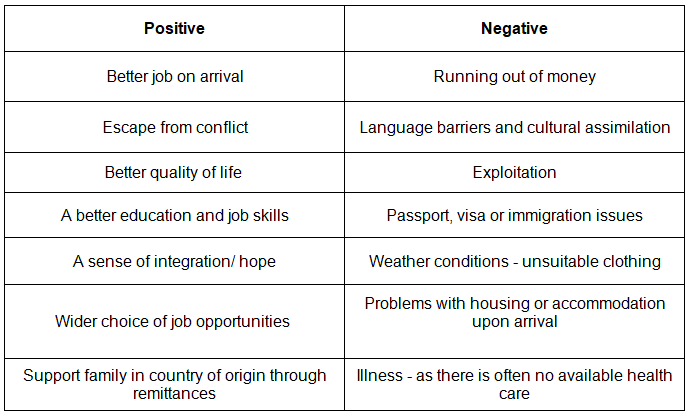Class 10 Exam > Class 10 Notes > Geography for GCSE/IGCSE > Impacts of Migration
Impacts of Migration | Geography for GCSE/IGCSE - Class 10 PDF Download
Impacts on the Destination & Origin of Migrants
- International migration has been a long-standing phenomenon that has significantly influenced global cultures and cities like New York, Paris, and London.
- According to the World Bank (2012), international migration brings about substantial economic benefits for sending countries, receiving countries, and migrants themselves.
- However, there are dissenting views suggesting that these impacts may not always be positive, as concerns arise about the potential loss of cultural identity resulting from both international and internal migration.
- Impacts on Country of Destination
Impacts on Country of Destination

Impacts on Country of Origin

Impacts on Migrants

- Remittances are significant for the country of origin, especially in developing nations like Bangladesh, India, Nepal, and Mexico.
- They are viewed as a form of 'bottom-up globalization' since they can make up to 20% of the annual GDP, leading to various positive impacts:
- Helping decrease poverty
- Creating a multiplier effect and boosting investment in a region
- Softening the blow of a global economic downturn
- The primary sources of remittances include the USA, Germany, UK, Western Europe, and the Persian Gulf.
- In 2021, the top five recipient countries were India, China, Mexico, the Philippines, and Egypt.
Question for Impacts of MigrationTry yourself: What are some positive impacts of remittances on the country of origin?View Solution
Case Study - International Migration from Mexico to the USA
- One prominent instance of international migration involves individuals moving from Mexico to the United States.
- This migration route stands as one of the most significant international labor migration streams globally.
- Historically, there were two smaller waves of migration in the 1920s and 1950s, encouraged by the US government for temporary recruitment of Mexican guest workers.
- However, the substantial and persistent mass movement of people between Mexico and the USA has primarily emerged within the last 40 years.
- The states of California, Arizona, New Mexico, and Texas witness higher concentrations of Mexican migrants due to various factors:
- Proximity to the border
- Increased demand for immigrant farm workers
- Long-established urban Mexican communities
- Approximately 24% of foreign-born residents in the USA are of Mexican origin, representing over 10.9 million individuals.
- Mexican nationals account for 51% of all unauthorized immigrants in the US, as reported by the Migration Policy Institute in 2020.
- In recent years, the number of Mexican migrants has declined due to several reasons, including:
- Heightened immigration enforcement
- Economic improvements in Mexico
- Increased presence of US Border Patrols
- The impact of the COVID-19 pandemic
Arguments Against Mexican Immigration
Some arguments opposing Mexican immigration include concerns such as:
- Negative environmental impacts due to population growth
- Perceived threats to established US culture
- Competition with low-skilled US workers for employment
- Potential rise in crime and illicit activities due to low incomes
- Increased burdens on healthcare, education, and detention systems
Advantages Brought by Mexican Immigrants
Conversely, proponents highlight various benefits that Mexican immigrants have brought to the United States, including:
- The widespread teaching of Spanish in US schools, enriching the skills of young learners
- Increased tax contributions to the government
- Rising popularity of Mexican cuisine and music in the US
- Cultural celebrations like the National Taco Day in the United States
Pull Factors
- Higher average incomes in the USA
- Lower unemployment rates in the USA
- High population growth in Mexico resulting in faster labor force growth and competition for few available jobs
- Quality of life is better in the USA than in Mexico
- Ability to send remittances back to Mexico
Push Factors
- High crime rates in Mexico
- Higher unemployment and poverty rates
- High rates of subsistence farming
- Hot arid and semi-arid conditions cause water shortages, limiting agricultural potential
- Natural hazards such as earthquakes
Impacts of Migration on Mexico
- Rural areas experience a shortage of economically active individuals
- In certain rural regions, there is a gender imbalance with women facing challenges in finding suitable partners
- Specific villages like Santa Ines have witnessed a significant decline in population
- Remittances from Mexicans in the US have emerged as a vital income source for Mexico, boosting the economy
- In Axochiapan, the absence of husbands and fathers for extended periods has led to women shouldering the responsibility of raising children, with the community increasingly reliant on remittances
- Critics contend that reliance on remittances may hinder local initiatives and motivation for progress
- Youth migration results in an aging population in these communities
- Decreased birth rates spell a gradual decline for these localities
Impacts of Migration on the Country of Destination - U.S.A.
- Illegal immigration leads to significant expenses for the U.S., including costs for border patrols, fences, and detention centers.
- Mexican immigrants are often viewed as a burden on the U.S. economy.
- Migrant workers contribute to keeping wages low, impacting unskilled American workers.
- The presence of migrant communities can escalate cultural and racial tensions in urban areas.
- The U.S. economy benefits from the labor of low-wage Mexican migrants.
- Mexican culture has greatly influenced the U.S. border states, introducing elements like food, language, and music (e.g., National Taco Day, mariachi bands).
- A significant number of illegal Mexican immigrants are employed in various sectors such as restaurants, janitorial services, transportation, gardening, construction, and manual labor.
- Tensions between Mexican immigrants and other ethnic groups have risen due to concerns about job availability for working-class Americans and other immigrant communities.
- Opposition to illegal immigration has spurred the creation of 'Minutemen' groups, civilian organizations that monitor U.S. borders and confront undocumented workers nationwide.
- Remittances, money sent by immigrants to their home countries, are perceived as economic losses for the U.S. In 2021 alone, $48.9 billion was remitted to Mexico from the U.S.
Question for Impacts of MigrationTry yourself: What are some factors that have contributed to the higher concentrations of Mexican migrants in certain states in the USA?View Solution
The document Impacts of Migration | Geography for GCSE/IGCSE - Class 10 is a part of the Class 10 Course Geography for GCSE/IGCSE.
All you need of Class 10 at this link: Class 10
|
55 videos|68 docs|78 tests
|
FAQs on Impacts of Migration - Geography for GCSE/IGCSE - Class 10
| 1. What are the impacts of international migration from Mexico to the USA? |  |
Ans. The impacts of international migration from Mexico to the USA include economic benefits for both countries, cultural exchanges, and challenges related to integration and discrimination.
| 2. How does migration from Mexico to the USA affect the destination country? |  |
Ans. Migration from Mexico to the USA can lead to an increase in the labor force, cultural diversity, and economic growth in the destination country. However, it can also create social tensions and strains on public services.
| 3. What are some of the challenges faced by Mexican migrants in the USA? |  |
Ans. Mexican migrants in the USA often face challenges such as language barriers, discrimination, legal issues, and difficulties in accessing healthcare and education.
| 4. How does international migration impact the origin country, Mexico? |  |
Ans. International migration from Mexico to the USA can result in a loss of skilled workers, known as brain drain, but it also leads to remittances sent back to Mexico, which can boost the country's economy.
| 5. What are some of the social and cultural impacts of migration from Mexico to the USA? |  |
Ans. Migration from Mexico to the USA can result in the preservation and transmission of cultural traditions, as well as the blending of cultures. However, it can also lead to social isolation and identity struggles for migrants.
Related Searches















